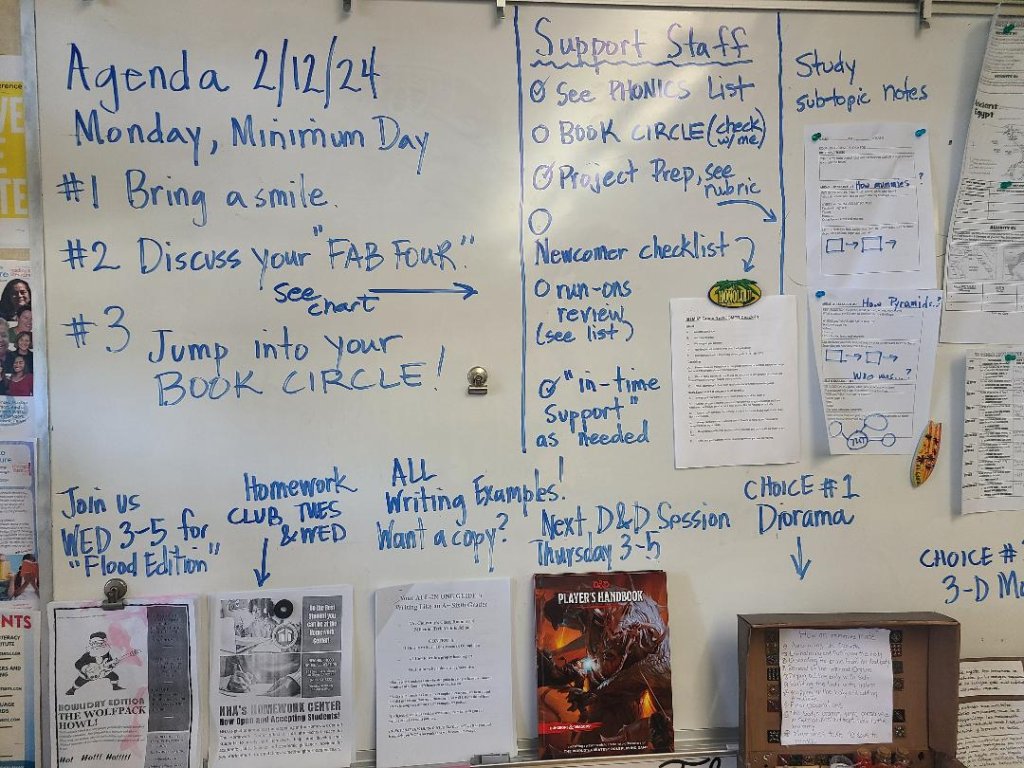How to Get the Most Out of a Focus Wall in Your Classroom
Helping students stay on track or explore more challenging work, a focus wall offers up-to-date information and necessary scaffolds.
Your content has been saved!
Go to My Saved Content.Every student likes to know what it is that a teacher wants from them—in concrete and tangible terms. Some like to be challenged, and many students still need heavy scaffolding. In our modern classrooms, students and adults of every variety come in and out, and each of them needs something different. This is why I love using a focus wall. It’s the one place in my classroom where I can give everyone exactly what they need in real time.
Focus walls have been around for a while. They typically serve as a place to post the objectives for core subjects. Sometimes, a focus wall is used to list step-by-step objectives that students must master to complete a unit of instruction. I’ve used a focus wall in the same way.
In my middle school classroom, the focus wall isn’t just a place to put what I want to see students learn, it’s a place where I put the actual work I want to see them do, differentiated. Expectations become clear and transparent for what I want, hope, and in some cases wish kids could do. A focus wall saves time, raises expectations, and helps kids’ learning. I use this type of focus wall to support, challenge, and scaffold every level of learner.
Post Scaffolds, Final Products, Student Examples and Rubrics
As a writing teacher, I post the pre-writing work we do on my focus wall. This includes any modeled, guided, or shared writing I do with the class. When we’re drafting, I post my own drafts, done with students or not, for them to use as a guide. I also post resources for editing, revising, and examples of how students should organize their folders.
When we finish, I post examples of exemplary student work (with rubrics) that I most want the class to see. Finally, I post various ways that work can be done for students who need additional support, as well as extension activities for advanced learners. All of this could be re-created for any subject area.
bring support staff together in the real, chaotic classroom
I wish I could say that I’m always on the same page as the many support staff who work in my chaotic classroom. But that just isn’t so, and again, focus walls help.

When occupational therapists, speech pathologists, special education coordinators, English language coordinators, and paraeducators come in tomorrow to push in, all they need to do in Room 3104 is look left at the focus wall. There, they’ll see our agenda, which details where we are in the unit. Next to that, there are the scaffolds, rubrics, and ideal end products I want. They’ll also see differentiated alternatives that they can help students achieve. In a section on the focus wall meant for adults called “Support,” I’ve written down tasks with which I could use some assistance.
For example, while the bulk of the class works on multiple-paragraph essays, others are working on more personalized goals. Several students in my first period have individualized education programs, and most of them are working on the goal of writing a paragraph that sticks to a topic. Other students are on the cusp of passing their English language proficiency exam this year and should review writing short constructed responses. Some simply need help getting started because they’ve missed a lot of class or haven’t developed enough writing stamina.
In each scenario, support providers can work with students on their caseload, while bridging to work that the entire class is doing because it’s explicitly available for them. I’ve often found that staff come into my room, see the focus wall, take a quick walk around, and can spot kids who will benefit from their support. Many of these folks are well trained and can help kids bridge gaps by using the focus wall as a guide.
challenge those advanced learners
Transfer of learning. Good teachers teach, guide learners, and create. But Bloom’s taxonomy tells us there are deeper parts to the learning process, like application. That is where the transfer of learning happens. Where students move to independence and self-discovery. A focus wall is a great way to bridge that gap—especially for advanced learners.
In my class, I reserve a section of the focus wall for “So you think you’re done?” Sometimes, I simply call it the “Challenge Yourself” section. Whatever you decide to call it, here’s what I recommend that you put there: examples of student work or ideas of what could be a student’s work that are a near extension of a current expectation. If you don’t have previous work, ask a colleague who keeps files, or find one on the internet. And whatever you do, make these extension activities and products as authentic to the students and to the school as possible.
For example, students in my writing class earlier in the year wrote an introductory five-paragraph essay we called “All About Me.” Now that the students had the structure of an essay in place, I used my focus wall to challenge early finishers by showcasing examples of other essays from previous years using our method. What did I get? Students turned in passion reports like “All About My BFF, Stacy” and a lovely essay explaining “Why I Love Star Wars.”
With very little direction on my part, I also received several articles for our school newspaper, and some students wrote letters to their parents for Back-to-School Night about why they were proud of their new writing skills. Each of these extension activities didn’t just challenge my kids—they also brought some students into the newspaper club, and for other learners, they made a lasting impression with parents.
Using a focus wall to post more than just objectives and standards gives concrete examples and calibration of what real work looks like. Focus walls can bring the conversation back to what is possible, instead of impossible, for our students.
